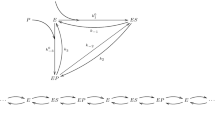Abstract
Experience collected in mesoscopic dynamic modeling of externally driven systems indicates absence of potentials that could play role of equilibrium or nonequilibrium thermodynamic potentials yet their thermodynamics-like modeling is often found to provide a good description, good understanding, and predictions that agree with results of experimental observations. This apparent contradiction is explained by noting that the dynamic and the thermodynamics-like investigations on a given mesoscopic level of description are not directly related. Their relation is indirect. They both represent two aspects of dynamic modeling on a more microscopic level of description. The thermodynamic analysis arises in the investigation of the way the more microscopic dynamics reduces to the mesoscopic dynamics (reducing dynamics) and the mesoscopic dynamic analysis in the investigation of the result of the reduction (reduced dynamics).
Similar content being viewed by others
References
Arnold, V.: Sur la géometrie différentielle des groupes de Lie de dimension infini et ses applications dans l hydrodynamique des fluides parfaits. Annales de l Institut Fourier (1966)
Beretta, C.: Steepest entropy ascent model for far-nonequilibrium thermodynamics: unified implementation of the maximum entropy production principle. Phys. Rev. E 90(4), 042113 (2014). doi:10.1103/PhysRevE.90.042113
Beris, A.N., Edwards, B.J.: Thermodynamics of Flowing Systems. Oxford University Press, Oxford (1994)
Cahn, J., Hilliard, J.: Free energy of a nonuniform system. I. Interfacial free energy. J. Chem. Phys. 28, 258–267 (1958)
Callen, H.: Thermodynamics: An Introduction to the Physical Theories of Equilibrium Thermostatics and Irreversible Thermodynamics. Wiley, Hoboken (1960)
Cattaneo, C.: Sulla conduzione del calore, Atti del Seminario Matematico e Fisico della Universita di Modena 3, 83101 (1948) (in Italian)
Clebsch, A.: Über die Integration der Hydrodynamische Gleichungen. Journal für die reine und angewandte Mathematik 56, 1–10 (1859)
Cross, M.C., Hohenberg, P.C.: Pattern formation outside equilibrium. Rev. Mod. Phys. 65(3), 851 (1993)
Desvillettes, L., Villani, C.: On the trend to global equilibrium for spatially inhomogeneous kinetic systems: The Boltzmann equation. Invent. Math. 159(2), 245–316 (2005)
Dzyaloshinski, I.E., Volovick, G.E.: Poisson brackets in condense matter physics. Ann. Phys. (NY) 125(1), 67–97 (1980)
Favis, B.D., Chalifoux, J.P.: The effect of viscosity ratio on the morphology of polypropylene/polycarbonate blends during processing. Poly. Eng. Sci. 27, 1591–1600 (1987)
Ginzburg, V., Landau, L.: On the theory of superconductivity. Zhur. Eksp. Theor. Fiz. 20, 1064–1082 (1950)
Gorban, A.N., Karlin, I.V.: Invariant Manifolds for Physical and Chemical Kinetics. Lecture Notes in Physics, vol. 660. Springer, Berlin (2005)
Gorban, A.N., Karlin, I.V.: Hilberts 6th problem: exact and approximate hydrodynamic manifolds for kinetic equations. Bull. Am. Math. Soc. 51(2), 187–246 (2014). doi:10.1090/S0273-0979-2013-01439-3
Grad, H.: On Boltzmanns H-theorem. J. Soc. Ind. Appl. Math. 13(1), 259–277 (1965)
Grmela, M.: Kinetic equation approach to phase transitions. J. Stat. Phys. 3, 347–364 (1971)
Grmela, M.: Onsager’s symmetry in higher order fluid dynamics. Helv. Phys. Acta 50, 393–406 (1977)
Grmela, M.: Particle and bracket formulations of kinetic equations. Contemp. Math. 28, 125–132 (1984)
Grmela, M.: Bracket formulation of diffusion-convection equations. Physica D 21, 179 (1986)
Grmela, M.: Reciprocity relations in thermodynamics. Physica A 309(3), 304–328 (2002)
Grmela, M.: Multiscale equilibrium and nonequilibrium thermodynamics in chemical engineering. Adv. Chem. Eng. 39, 75 (2010)
Grmela, M.: Fluctuations in extended mass-action-law dynamics. Physica D 241, 976–986 (2012)
Grmela, M.: Geometry of mesoscopic nonequilibrium thermodynamics. Entropy 17, 5938–5964 (2015)
Grmela, M., Öttinger, H.C.: Dynamics and thermodynamics of complex fluids. I. Development of a general formalism. Phys. Rev. E 56, 6620 (1997)
Grmela, M., Klika, V., Pavelka, M.: Reductions and extensions in mesoscopic dynamics. Phys. Rev. E 92(3), 032111 (2015)
Jordhamo, G.M., Manson, J.A., Sperling, L.H.: Phase continuity and inversion in polymer blends and simultaneous interpenetrating networks. Poly. Eng. Sci. 26, 517–524 (1986)
Jou, D., Casas-Vzquez, J., Lebon, G.: Extended Irreversible Thermodynamics, 4th edn. Springer, Berlin (2010)
Kaufman, A.N.: Dissipative Hamiltonian systems: a unifying principle. Phys. Lett. A 100, 419–422 (1984)
Keizer, J.: On the kinetic meaning of the second law of thermodynamics. J. Chem. Phys. 64, 4466–4474 (1976)
Lucia, U., Grazzini, G.: Second law today: using maximum-minimum entropy generation. Entropy 17, 778–7797 (2015)
Marsden, J., Weinstein, A.: Coadjoint orbits, vortices, and Clebsch variables for incompressible fluids. Physica D 7, 305–323 (1983)
Morrison, P.J.: Bracket formulation for irreversible classical fields. Phys. Lett. A 100, 423–427 (1984)
Müller, I., Ruggeri, T.: Rational Extended Thermodynamics. Springer, New York (1998)
Öttinger, H.C.: Beyond Equilibrium Thermodynamics. Wiley, New York (2005)
Öttinger, H.C., Grmela, M.: Dynamics and thermodynamics of complex fluids. II. Illustrations of a general formalism. Phys. Rev. E 56, 6633 (1997)
Pavelka, M., Klika, V., Grmela, M.: Time reversal in nonequilibrium thermodynamics. Phys. Rev. E 92, 032111 (2015)
Prigogine, I.: Thermodynamics of Irreversible Processes. Wiley, New York (1955)
Pëschel, T., Brilliantov, N.V. (eds.): Granular Gas Dynamics. Lecture Notes in Physics, vol. 624. Springer, Berlin (2003)
Ruggeri, T., Sugiyama, M.: Rational Extended Thermodynamics Beyond the Monoatomic Gas. Springer, Heidelberg (2015)
Acknowledgements
This research was partially supported by the Natural Sciences and Engineering Research Council of Canada. Funding was provided by Canadian Network for Research and Innovation in Machining Technology, Natural Sciences and Engineering Research Council of Canada (06504 CRSNG, 462034-2014 CRSNG).
Author information
Authors and Affiliations
Corresponding author
Rights and permissions
About this article
Cite this article
Grmela, M. Externally Driven Macroscopic Systems: Dynamics Versus Thermodynamics. J Stat Phys 166, 282–316 (2017). https://doi.org/10.1007/s10955-016-1694-6
Received:
Accepted:
Published:
Issue Date:
DOI: https://doi.org/10.1007/s10955-016-1694-6




